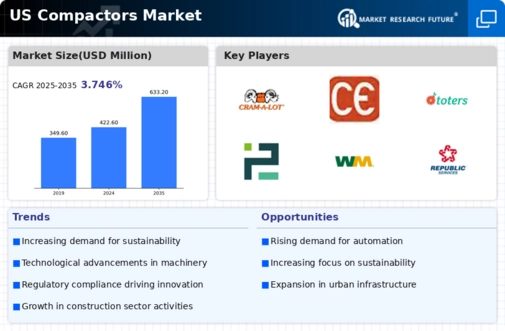Rising Urbanization
The ongoing trend of urbanization in the US is driving the compactors market. As cities expand, the need for efficient waste management solutions becomes increasingly critical. Urban areas generate a significant amount of waste, necessitating the use of compactors to optimize space and reduce collection frequency. According to recent data, urban centers account for approximately 80% of the total waste generated in the US. This growing urban population, projected to reach 90% by 2050, indicates a robust demand for compactors. The compactors market is likely to benefit from this trend, as municipalities and private waste management companies seek to enhance their operational efficiency and sustainability efforts. Furthermore, the integration of compactors in urban planning is expected to become a standard practice, further solidifying their role in waste management.
Evolving Regulatory Landscape
The evolving regulatory landscape in the US is shaping the compactors market. Stricter waste management regulations are being implemented at local, state, and federal levels, compelling businesses to adopt more efficient waste disposal methods. Compliance with these regulations often necessitates the use of compactors, which help organizations manage waste more effectively. The compactors market is likely to experience growth as companies invest in equipment that meets regulatory standards. Additionally, the push for zero waste initiatives is prompting businesses to seek innovative solutions, further driving the demand for compactors. This regulatory influence suggests that the compactors market will continue to evolve, with an emphasis on compliance and sustainability in waste management practices.
Growing Environmental Awareness
The rising environmental awareness among consumers and businesses is influencing the compactors market. As sustainability becomes a priority, organizations are increasingly seeking solutions that minimize their ecological footprint. Compacting waste reduces the volume sent to landfills, thereby contributing to waste reduction efforts. The compactors market is likely to see growth as companies adopt compactors to align with their sustainability goals. Furthermore, regulatory bodies are encouraging waste reduction practices, which may lead to increased investments in compactors. The market is expected to expand as businesses recognize the long-term benefits of adopting environmentally friendly waste management solutions. This shift in consumer behavior indicates a promising future for the compactors market, as more entities prioritize sustainable practices.
Increased Construction Activities
The resurgence of construction activities across the US is significantly impacting the compactors market. With infrastructure projects and residential developments on the rise, the demand for compactors is expected to grow. Construction sites generate substantial waste, and compactors are essential for managing this waste efficiently. The construction sector is projected to grow at a CAGR of 5% over the next five years, which will likely lead to an increased need for compactors. The compactors market is poised to capitalize on this growth, as contractors and builders prioritize waste management solutions that enhance site productivity and reduce costs. Additionally, the adoption of compactors in construction aligns with sustainability goals, as they help minimize the environmental impact of construction waste.
Technological Advancements in Waste Management
Technological advancements are reshaping the compactors market, offering innovative solutions that enhance efficiency and performance. The integration of smart technologies, such as IoT and automation, is becoming increasingly prevalent in waste management. These technologies allow for real-time monitoring of compactor performance, optimizing collection schedules and reducing operational costs. The compactors market is witnessing a shift towards more sophisticated equipment that not only compacts waste but also provides data analytics for better decision-making. As municipalities and businesses seek to improve their waste management strategies, the demand for technologically advanced compactors is likely to rise. This trend suggests a future where compactors are not just machines but integral components of a smart waste management ecosystem.



















Leave a Comment